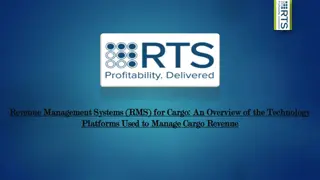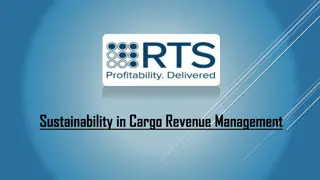
Key Metrics for Air Cargo Revenue Management- RTSCorp's Essential KPIs
In the dynamic world of air cargo revenue management, understanding and optimizing key performance indicators (KPIs) is critical for ensuring profitability and operational efficiency. Companies like RTSCorp emphasize these metrics to provide a roadma
- cargo cloud solutions
- air cargo pricing
- cargo revenue
- cargo revenue management
- cargo solutions
- cargo strategy consulting
Download Presentation

Please find below an Image/Link to download the presentation.
The content on the website is provided AS IS for your information and personal use only. It may not be sold, licensed, or shared on other websites without obtaining consent from the author. Download presentation by click this link. If you encounter any issues during the download, it is possible that the publisher has removed the file from their server.
E N D
Presentation Transcript
KEY METRICS FOR AIR CARGO REVENUE MANAGEMENT: RTSCORP'S ESSENTIAL KPIS
In the dynamic world of air cargo revenue management, understanding and optimizing key performance indicators (KPIs) is critical for ensuring profitability and operational efficiency. Companies like RTSCorp emphasize these metrics to provide a roadmap for maximizing revenue while maintaining service excellence. Let s explore the essential KPIs that drive success in air cargo revenue management. 1. Cargo Load Factor (CLF) Cargo cargo Factor is a vital KPI that measures the chance of available weight capacity employed on a flight. Calculated by dividing the revenue-generating freight (in weight or volume) by the total available capacity, CLF provides a snapshot of efficiency. High CLF indicates optimal usage of resources, while low CLF may signal opportunities for better planning or pricing adjustments. 2. Revenue per Available Ton Kilometer (RATK) RATK measures the revenue generated per ton of cargo per kilometer flown. It is an industry-standard metric that combines pricing strategy with capacity utilization. Monitoring RATK helps air cargo operators understand how well their pricing aligns with market demand, making it a cornerstone for strategic decision-making. 3. Yield per Kilogram Yield per kilogram evaluates the revenue earned for every kilogram of cargo transported. This KPI is influenced by pricing strategies, surcharges, and market conditions. A focus on yield ensures profitability, even in competitive markets. Companies like RTSCorp integrate this metric into pricing models to strike a balance between competitiveness and revenue maximization.
4. Booking Forecast Accuracy Effective air cargo revenue management hinges on accurate forecasting. Booking forecast accuracy compares predicted bookings against actual figures to evaluate the reliability of demand forecasts. RTSCorp s sophisticated algorithms and historical data analyses allow operators to minimize overbooking or underutilization, enhancing operational planning. 5. Market Share Analysis Understanding an airline s share in the global air cargo market is essential for benchmarking performance. This KPI not only tracks growth but also identifies areas for improvement. By analyzing trends, RTSCorp helps operators refine their strategies to stay competitive. 6. Revenue Leakage Revenue leakage occurs when potential earnings are lost due to inefficiencies like pricing errors, billing issues, or missed sales opportunities. Tracking this KPI is crucial for identifying and rectifying gaps in the revenue management process. 7. Transit Time Reliability In an industry where timely delivery is critical, tracking transit time reliability ensures customer satisfaction and repeat business. Reliable operations often translate to higher customer loyalty and, ultimately, improved revenue.
Final Thoughts Air cargo revenue management is as much about numbers as it is about strategic insights. The key metrics outlined above, when monitored and optimized, provide the foundation for success. RTSCorp s focus on these essential KPIs enables businesses to adapt to market demands, enhance profitability, and sustain growth in a competitive landscape. By aligning these metrics with innovative tools and strategies, companies can navigate the complexities of air cargo revenue management and secure their position as industry leaders.






















